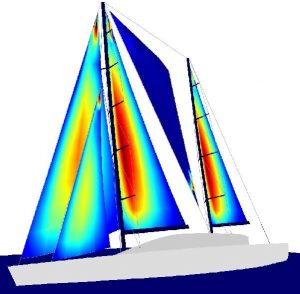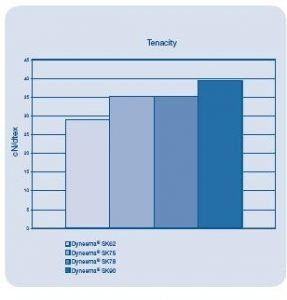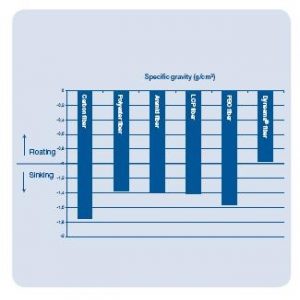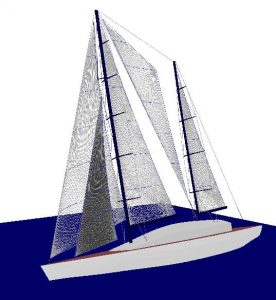Why Dyneema and Membrane?
WHY DYNEEMA?
Dyneema is a synthetic fiber of ultra high molecular weight polyethylene (UHMWPE), with important features such as:
- extraordinary tensile, flexural and impact strenght
- high resistance to corrosive chemicals, abrasion and UV rays
- low coefficient of friction, specific gravity, and moisture absorption
- extraordinary strenght-to-weight ratio
Dyneema is the greatest fiber for sailmakers due to the following reasons:
- High resistance to stress, shocks and folding of the sail
- Soft handling with less weight and thickness of the laminate
- More durability and high preservation of the original shape
Most commonly seen in superyachts, dyneema has great properties when used for offshore racing, combined with hi-modulus carbon or aramid fibers in the proper areas of the sail structure.
Having the highest strength-to-weight ratio and tensile, flexural and impact strength of any comparable fibers, top grades of DSM Dyneema is our choice, the best for sailmaking purpose:
Dyneema sk75 and sk90.
Dyneema® SK90 in particular features an even higher modulus (resistance to stretch) and strength when compared to other Dyneema® grades, while preserving existing attributes. Sails designed with higher modulus fibers offer more direct control while sailing and less energy absorption so you experience more precise trim control.
In addition Dyneema® SK90’s lighter weight helps reduce the loads above the waterline, an overriding goal of every sailor.
Altought, it’s not easy to laminate dyneema fibers to create a sailcloth because of its own features (like self lubricating and low absorption); it takes lots of efforts in technical prowess, development, retooling in production and testing (on water and in lab).
Today MEMBRANE is the only system properly laminating Dyneema fibres in a sailcloth.
WHY MEMBRANE
MEMBRANE is not only a specific material made by our innovative and exclusive technologies but is a different approach to the building process of a sail with no dimensional limits:
MEMBRANE is ART, SCIENCE, TECHNOLOGY and CRAFTSMANSHIP.
In the Banks Sails lamination facility, one of the largest in Europe, we
produce up to 30m x 6m light and strong advanced sail panels.
Combinations of the best raw materials merge into our sails thanks to
our high pressure flat lamination.
An accurate sail design is the first step of the MEMBRANE integrated
Banks Sails proprietary system. Banks Sails software has been created
exclusively for our designer’s needs and requirements.
The Sail Design
- 3D Modeling: with the 3D modeling software our designer is able to reproduce rig, hull and deck plan of the yacht, to calculate the exact flying sail shape and dimensions required.
- Aero Analisys: the CFD unit of the software enables us to find the optimum lift to drag ratio of the un-deformed sail.
 (Aeroelastic studies for a Perini 50m SY)
(Aeroelastic studies for a Perini 50m SY)
- 3D Fiber Layout: futuristic structures in continuous evolution follow the natural load and stress paths. In the sail every single line, every curve satisfies specific structural needs, both aesthetical and functional.
- Aeroelastic Analisys: our finite element software (FEA) calculates the deformed sail shape with wind and rig loads applied. Then CFD analysis calculates lift to drag ratio and CP position for the deformed (real) sail.
On water testing:
the BanksSails lamination facility is next door to the design centre and sail-loft, the close loop between design, lamination, manifacturing and on the water testing is the key to fast track winning development process. Sometimes only few hours separate an idea from the actual on the water sailing.
After the sail is accurately designed, the process goes on with the next step: the creation of the sail cloth.
The process
- First skin and fibers lay down: a first skin, Mylar film or taffeta, is alid flat on the lamination surface. An automatic head alys the fiber curved on the defined paths(?). while most of the internal fialments remain dry and soft to folding, the fiber outer surfaces are glued together for the best grid resistance.
- Two component glue layer application: our specialized Polyester two component gluereduces the amount required in the lamination process: this way we get stronger and lighetr material. The bonfding process with bi-component glue, differently from the thermoplastic processes, is no more reversible; this is the only process that grant an excellent Dyneema yarns correct lamination with molecular cross linking.
- Second skin lay down and vacuum application: powerful vacuum pumps suck the air out of the two sealed skins on an extra-flat glass floorensuring an excellent vacuum depression.
- One pass heating process: MEMBRANE uses infrared variable temperature lamps whose purpose is to liquefy the resin (not to activate it) and start the cross-linking process. The lamps covers the full width of the table so the material is uniformly heated with no “woven” distortion.
- High pressure: The high pressure rollers follow the infra red lamps, eliminating the air pockets, applying up to 90.000 Kg/Sqm compacting the various layers. Thus allowing great fiber concentration in the maximum load corners. High pressure is an essential key point in laminating Dyneema fibers into the MEMBRANE.
- Flat vacuum cooling process: we match a monolithic composite material avoiding all the alterations wich may be caused by the thermo-molded 3D laminations. For Dyneema Membranes the post-curing process may last up to several days to wait the complete molecular cross-linking.
- Curves drawing a stabilized flat material: this important key point allows the repeatability of a winning design as well as the perfect symmetry of the sail on both tacks. The final shapeis not dependent on being distorted over a 3D mould.
Double Taffeta Constructions
MEMBRANE taffeta components offer the highest UV resistance and ant-mildew due to the extensive use of Titanium dioxide (TiO2), anti- mildew agents and UV absorbers throughout their construction.
The use of the TiO2 also gives the taffeta membranes a more traditional white sail appearance, which also was one of the requests brought to us by our customers.
For super yachts we are able to create a multiple layer laminate to ensure more resistance in the overlap areas and in stress points of the sails and to better distribute the high amount of fiber in the cloth.
CRUISE Dyneema® and RACE QD
The only choice for maxi yachts and offshore racing.
Allegati: Why Dyneema and Membrane ↓







